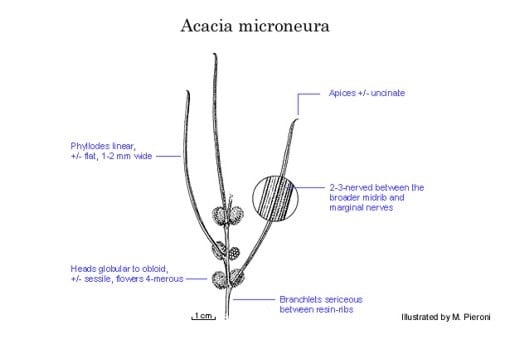Acacia microneura Meisn.
WATTLE
Acacias of Australia
Family
Fabaceae
Distribution
Known only from Cranbrook, south-western W.A.
Description
Shrub with young branchlets resinous-angled, white appressed-puberulous between angles. Phyllodes ascending, linear, straight to incurved or ±sigmoid, flat to slightly compressed-rhombic in section, 4–11 cm long, 1–2 mm wide, uncinate-acute, appressed-puberulous basally and between nerves, with central nerve and marginal nerves broader and more raised than the c. 3 finer closely parallel nerves in between. Inflorescences simple, 1 or 2 per node; peduncles 0–1 mm long, appressed-puberulous; heads globular to broadly ellipsoid or obloid, 5.5–6 mm long, 5.5 mm diam., ±20-flowered; bracteoles spathulate, puberulous. Flowers 4-merous; sepals at least 3/4-united. Pods and seeds not seen.
Habitat
Grows in sand in heath.
Specimens
W.A.: Cranbrook, A.M.Ashby 4681 (CANB, K, MEL, PERTH).
Notes
Superficially similar to A. epedunculata which has a single prominent, resinous nerve and 2 weaker nerves per face and pentamerous flowers. The linear, elongate phyllodes and ±sessile, broadly ellipsoid to obloid flower-heads are reminiscent of some collections of A. mimica var. angusta (sect. Plurinerves) but that taxon differs especially in having phyllodes with equally prominent nerves and pentamerous flowers. Superficially similar to A. phasmoides (sect. Phyllodineae) from eastern Australia.
FOA Reference
Data derived from Flora of Australia Volumes 11A (2001), 11B (2001) and 12 (1998), products of ABRS, ©Commonwealth of Australia
Author
R.S.Cowan
This identification key and fact sheets are available as a mobile application:
URL: https://apps.lucidcentral.org/wattle/
© Copyright 2018. All rights reserved.







